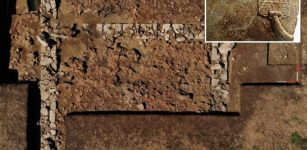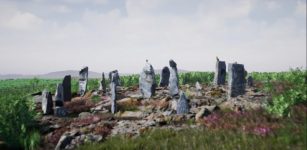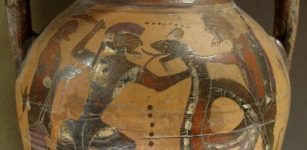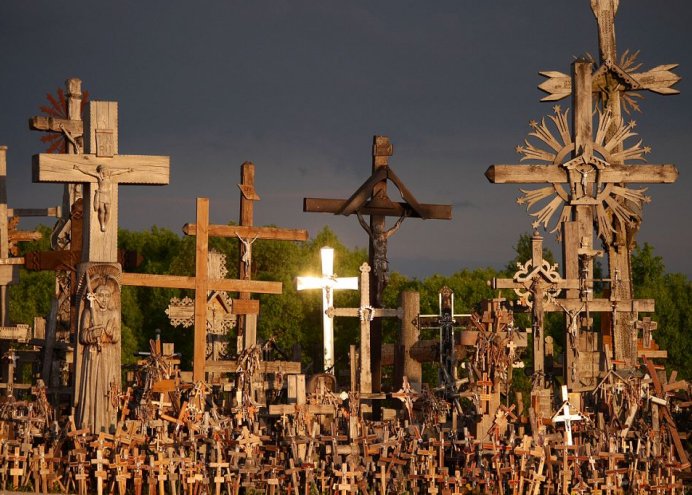Hill Of 100,000 Crosses In Lithuania Survived Against All Odds
Ellen Lloyd - AncientPages.com - For many centuries, people in Lithuania have put up crosses on a hill located about sixteen kilometers from Šiauliai, a city in the North.
Over the years, many attempts were made to end this practice, but people never gave up and continued to place crosses on the hill. Today the place is known as the Hill of Crosses and it has become a symbol not only of faith, but also a reminder of resistance against oppression.
The hill is 60 meters long and 40-50 meters wide and it is believed the first cross was placed here by the relatives of the victims of the Lithuanian rebellion in 1831.
Symbol Against Oppression
The Russian Tsar, Nicholas I and his government prohibited any kind of freedom and Russia was a typical police state with a wide net of spies and harsh punishments for any thought or action against the government. Countries like Lithuania and Poland, which had been subjugated by Russia made several revolts against the despotic regime.
People desired liberty, freedom, and independence, but the despotic atmosphere weighed on all Russia, and even more so on the subjugated countries.
In 1831, the tsarists government did not allow the families to honor their dead properly and people started to place crosses on the hill. After the second rebellion in 1863, there were even more crosses.
The crosses were first counted in 1900 and at the time there were 130 crosses on the hill. The number of crosses continued to rise, and the place took on a special significance during the years 1944–1990, when Lithuania was occupied by the Soviet Union.
See also:
10 Types Of Ancient Crosses In Different Cultures Explained
The Name Vatican And Etruscan Goddess Vatika Of The Underworld – What Is The Connection?
Lost Q Source Remains An Unsolved Biblical Mystery
Mystery Of The Lost Biblical City Of Ai – Where Was It Located?
In 1961, the Soviet government demolished over 5000 crosses, by 1975 – 1200 crosses more. The Soviet government considered the crosses and the hill a hostile and harmful symbol.
People in Lithuania did not give up. They continued to go to the Hill of Crosses, and leave their tributes, Lithuanians used it to demonstrate their allegiance to their original identity, religion and heritage. The Soviet government tried to destroy this sacred site on at least three occasions.
Hill Of Crosses Is A Sacred Site
There were even rumors that the authorities planned to build a dam on the nearby Kulvė River, so that the hill would end up underwater.
On September 7, 1993, Pope John Paul II visited the Hill of Crosses, declaring it a place for hope, peace, love and sacrifice. In 2000, a Franciscan hermitage was opened nearby.
Today the Hill of Crosses is visited by many people from different countries. Catholic pilgrims are placing here not only crosses, but also but statues of the Virgin Mary, carvings of Lithuanian patriots and thousands of tiny effigies and rosaries.
The number of crosses in 2006 was 100,000.
The crosses on the Hill of Crosses are also endless reminders of peoples’ misfortunes, sorrow and catastrophes. On September 28, 1994, MS Estonia was sailing from Estonia to Sweden. The weather was bad and the ferry sent a distress signal. Water flooded in through an open bay door. The ferry sank within five minutes. The total number of dead was 852 and some of them were rather poor people who had finally saves money and could make their first journey to Sweden.
After the MS Estonia catastrophe, one cross was put on the Hill of Crosses.
The cross is best known as a Christian symbol but this ancient universal symbol has its beginnings in the most remote times and there are several different types of crosses used by many ancient cultures.
Written by Ellen Lloyd – AncientPages.com
Copyright © AncientPages.com & Ellen Lloyd All rights reserved. This material may not be published, broadcast, rewritten or redistributed in whole or part without the express written permission of AncientPages.com and Ellen Lloyd
About the author:
Ellen Lloyd – is the owner of AncientPages.com and an author who has spent decades researching ancient mysteries, myths, legends and sacred texts, but she is also very interested in astronomy, astrobiology and science in general
More From Ancient Pages
-
 Ancient Mystery Of The Enigmatic ‘Cat Men’ – Advanced Prehistoric Machines Or Humanoids? – Part 2
Ancient Mysteries | Jan 20, 2021
Ancient Mystery Of The Enigmatic ‘Cat Men’ – Advanced Prehistoric Machines Or Humanoids? – Part 2
Ancient Mysteries | Jan 20, 2021 -
 On This Day In History: Battleship USS Maine Explodes And Sinks – On Feb 15, 1898
News | Feb 15, 2017
On This Day In History: Battleship USS Maine Explodes And Sinks – On Feb 15, 1898
News | Feb 15, 2017 -
 Great Sakya Library Is Home To 84,000 Scrolls Left Untouched For Hundreds Of Years
Featured Stories | Jul 22, 2021
Great Sakya Library Is Home To 84,000 Scrolls Left Untouched For Hundreds Of Years
Featured Stories | Jul 22, 2021 -
 Scientists Unravel The Mystery Of The Alexander Sawney Bean Legend & Cave-Dwelling Cannibals In Scotland
Myths & Legends | Sep 24, 2015
Scientists Unravel The Mystery Of The Alexander Sawney Bean Legend & Cave-Dwelling Cannibals In Scotland
Myths & Legends | Sep 24, 2015 -
 Clovis Culture: Will Ancient Tools Solve Mystery Of North America’s Earliest Inhabitants?
Archaeology | Oct 26, 2020
Clovis Culture: Will Ancient Tools Solve Mystery Of North America’s Earliest Inhabitants?
Archaeology | Oct 26, 2020 -
 Archaic Temple (Part Of God Poseidon’s Sanctuary) At The Kleidi-Samikon Site In Greece – Unearthed
Archaeology | Jan 12, 2023
Archaic Temple (Part Of God Poseidon’s Sanctuary) At The Kleidi-Samikon Site In Greece – Unearthed
Archaeology | Jan 12, 2023 -
 1,000-Year-Old Bone Skate Found In Moravian City Of Přerov, Czech Republic
Archaeology | Mar 20, 2024
1,000-Year-Old Bone Skate Found In Moravian City Of Přerov, Czech Republic
Archaeology | Mar 20, 2024 -
 Where Is The 12,000-Year-Old Map That Could Change All We Know About Ancient Egypt Hidden?
Ancient Mysteries | Mar 21, 2021
Where Is The 12,000-Year-Old Map That Could Change All We Know About Ancient Egypt Hidden?
Ancient Mysteries | Mar 21, 2021 -
 1,500-Year-Old Christian Reliquary Found In An Unknown Church In Irschen, Austria
Archaeology | Jun 26, 2024
1,500-Year-Old Christian Reliquary Found In An Unknown Church In Irschen, Austria
Archaeology | Jun 26, 2024 -
 Taíno Indians Are Not Extinct – Ancient Tooth Reveals Indigenous Americans Still Have Living Descendants In The Caribbean
Archaeology | Feb 21, 2018
Taíno Indians Are Not Extinct – Ancient Tooth Reveals Indigenous Americans Still Have Living Descendants In The Caribbean
Archaeology | Feb 21, 2018 -
 What Are The Most Common Misconceptions About Pirates?
Ancient History Facts | Apr 16, 2024
What Are The Most Common Misconceptions About Pirates?
Ancient History Facts | Apr 16, 2024 -
 Intriguing Petroglyphs Reveal Traces Of A Lost Ancient Civilization In India
Archaeology | Oct 4, 2018
Intriguing Petroglyphs Reveal Traces Of A Lost Ancient Civilization In India
Archaeology | Oct 4, 2018 -
 Lagina Sanctuary Of Goddess Hekate: Archaeologists Found Ceremonial ‘Sacred Road’
Archaeology | Jul 10, 2019
Lagina Sanctuary Of Goddess Hekate: Archaeologists Found Ceremonial ‘Sacred Road’
Archaeology | Jul 10, 2019 -
 Mythical Egyptian Bennu Bird And Deity
Egyptian Mythology | Jun 5, 2016
Mythical Egyptian Bennu Bird And Deity
Egyptian Mythology | Jun 5, 2016 -
 Star-Shaped Magnetic Anomaly At Hidden Stone Circle In The Outer Hebrides Gives New Insight Into Ancient Beliefs
Archaeology | Jan 2, 2020
Star-Shaped Magnetic Anomaly At Hidden Stone Circle In The Outer Hebrides Gives New Insight Into Ancient Beliefs
Archaeology | Jan 2, 2020 -
 Aqrabuamelu – Mysterious Scorpion Men In Babylonian Mythology
Featured Stories | Jan 19, 2016
Aqrabuamelu – Mysterious Scorpion Men In Babylonian Mythology
Featured Stories | Jan 19, 2016 -
 World’s Oldest Dictionaries Are 4,500-Year-Old Cuneiform Tablets Discovered In Ebla
Ancient History Facts | Aug 19, 2016
World’s Oldest Dictionaries Are 4,500-Year-Old Cuneiform Tablets Discovered In Ebla
Ancient History Facts | Aug 19, 2016 -
 Cadmus – Legendary Phoenician Hero And Founder Of Prosperous City Of Thebes
Featured Stories | Sep 6, 2023
Cadmus – Legendary Phoenician Hero And Founder Of Prosperous City Of Thebes
Featured Stories | Sep 6, 2023 -
 Ukko: Karelian-Finnish God Of Thunderstorms, Harvest, Patron Of Crops And Cattle
Featured Stories | Apr 2, 2020
Ukko: Karelian-Finnish God Of Thunderstorms, Harvest, Patron Of Crops And Cattle
Featured Stories | Apr 2, 2020 -
 On This Day In History: Great Siege of Malta: Ottoman Forces Made Attempt To Conquer Malta And Failed – On May 18, 1565
News | May 18, 2016
On This Day In History: Great Siege of Malta: Ottoman Forces Made Attempt To Conquer Malta And Failed – On May 18, 1565
News | May 18, 2016




